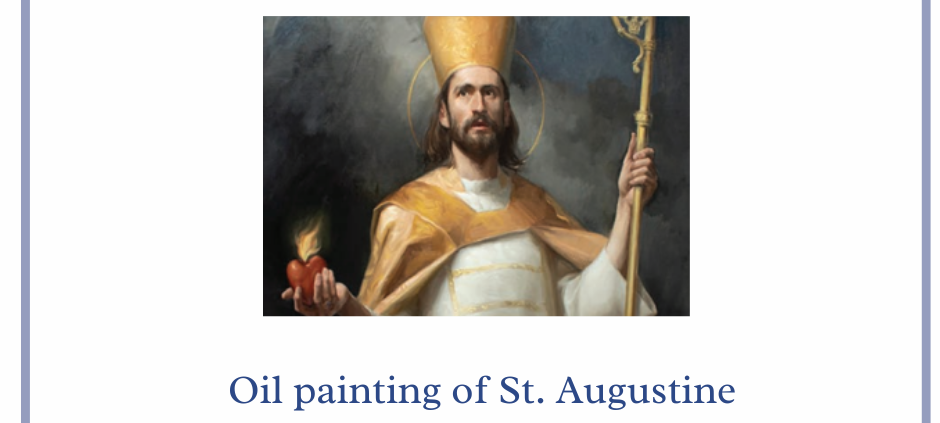Oil painting of St. Augustine continues a legacy of sacred art, beauty
Maura Baker
Staff Writer
In 1909, Cincinnati painter and devout Catholic Frank Duveneck put his finishing touches on murals to decorate the walls of the Cathedral Basilica of the Assumption, Covington. Restored by William Blank in 1920, these paintings still boldly decorate the Cathedral’s interior walls — just one example of sacred art that can be found in any number of the Diocese of Covington’s Catholic churches.
“In true beauty, we begin to experience the desire for God,” Pope Francis observed in an address to artists for the 50th anniversary of the Inauguration of the Vatican Museums’ Collection of Modern Art, 2023 — reminiscing on the long-standing friendship between artists and the Church.
St. Augustine also spoke often of beauty, famously lamenting “I have learnt to love you late, Beauty at once so ancient and so new!” in his work Confessions.
How fitting, then, that an oil painting done by an artist native to the diocese features the saint and philosopher — blessed on the feast of St. Augustine, Aug. 28, for St. Augustine Parish, Covington.
The four-and-a-half foot tall painting was commissioned for the church by pastor Father Daniel Schomaker, completed by painter Daniel Zalla during his residency year at the Florence Academy of Art in Florence, Italy this past year.
Mr. Zalla grew up in Villa Hills, as a parishioner of St. Joseph Parish in Crescent Springs, and of the Cathedral Basilica of the Assumption during his high school studies at Covington Latin School. While a friend of the family, Mr. Zalla came to know Father Schomaker during his time at Covington Latin as a pontifical server — during which time Father Schomaker was serving as master of ceremonies for Bishop Emeritus (then Bishop) Roger Foys. After graduating from Covington Latin in 2016, Mr. Zalla received his undergraduate degree in Fine Arts from Xavier University, before continuing his studies and eventually graduating from the Florence Academy of Art. He learned about the school following a week-long trip to Venice with a former professor.
After receiving the commission in February 2023, Mr. Zalla’s painting of St. Augustine is now proudly displayed in its parish home.
“The most symbolic representation of St. Augustine is identifiable because he’s holding the restless heart,” depicted commonly as a heart ablaze, Mr. Zalla said about the artwork. “That was something that Father Daniel specifically wanted in the painting, and that comes from St. Augustine’s line, ‘our hearts are restless until they rest in you.’”
The painting itself depicts St. Augustine with deliberate detail — dressed in bishop’s vestments and a miter and carrying a crozier. Emotionally, Daniel Zalla hoped to convey a sense of being “illuminated by the light of God” in the work, which he deemed suited due to St. Augustine’s role as a prolific Doctor of the Church, and his “connection with the Divine and inspiration.”
Symbolically, Mr. Zalla depicts this notion through light. The face, the robes, and most of the figure stand illuminated against the dark, gloomy background of the piece — like the light of God bringing him out of darkness, as Mr. Zalla described. This also helps to contrast the illumination from the fire emitting from the restless heart held in St. Augustine’s hand, which points upward and connects additionally to the highlights in the figure’s eyes.
Daniel Zalla composed the painting so that all lines would point upward to the heavens — carrying through the drapery in St. Augustine’s clothing, to the gesture of his hands and the shape of the clouds. “It keeps the energy in the painting pointing upward,” he said, “and that was very important to me.”
To Mr. Zalla, there is an importance in beauty — this culture of beauty is the primary reason he chose a career in classical painting.
“All these little decorative elements in a city, like if you see a light post with a decoration instead of a stark, minimalistic light post; I think it shows that humans are built for more than just doing something as efficiently as possible to get that job done. Having that element of decoration that’s completely unnecessary … we all recognize it as beautiful,” he said.
“It shows that we’re built for more than just this utilitarian purpose, but that we have a higher calling, and we’re connected to something greater than ourselves,” Mr. Zalla said. “When I look at classical painting, it’s the same kind of thing. Maybe painting isn’t necessary for life, but having this beauty around us connects us to a higher level. Maybe that’s an ambitious goal to shoot for, but to use paintings to help people connect with that ideal — that’s why painting is important.”



